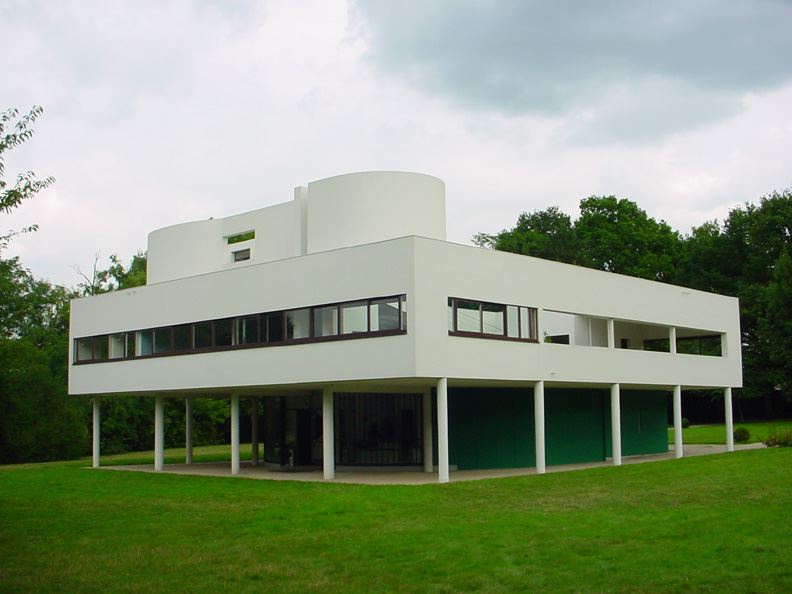Since around 1960, Le Corbusier has probably been posed as "the greatest" by more professors of architecture than any other individual. This guy was gifted and incredibly prolific He brought an intellectual range to the discipline of architecture that is probably unexcelled, and left a body of work that has occupied students and practitioners since early in his career.
 Image via Wikipedia
Image via WikipediaNo shrinking violet, he attacked cubism with a manifesto, labeling his POV "Purism." He'd have probably liked Philip Absolon's "Cassie Thinking About Cubism," 1996.

Heidi Weber Museum, Zurich
The wiki article in the first sentence provides plenty of biography. I'd like to address a few aspects of his work and what I see as his more significant influences on architects.
First, he organized proportioning with his own version of the Golden Mean. He called his system the Modulor. Without trying to pick at the various opinions that have been written over the years about Modulor, I think it proved a useful tool, if for no other reason than that it offered a systematic application for casting proportions of planar elements and spaces. The diagonal of the golden mean rectangle describes an angle of about 31.8 degrees to the rectangle's long sides. As a student I used a 30/60-degree triangle to rough in proportional schemes, and it worked just fine in planar layouts. A rule of thumb a lot of architects have used is to note the approximately 2/3 ratio of the square within the rectangle. So, major divisions within, say, a wall can often be seen at the 1/3 or 2/3 point of the height or width of the wall's elevation.

Golden Mean
Valid? Depends. It's possible to make a completely hideous design using this system, but it can underlie both simple and highly intricate organizations of elements in for example a building elevation. Again, I think the adoption of the Golden Mean or the Modulor as an organizing principle tends to lead to well-developed compositions, if for no other reason than that it is a visibly organized composition. How good it is depends on all the factors that underlie the designer's skill and knowledge of his craft.
Second, Corbu brought a lot more to the table than a scheme of proportions. He was quite literally a working artist in addition to practicing architecture. He developed a routine of painting in the morning, then going into the architecture studio in the afternoon. His point of view, with art on an equal footing with architecture, would seem to have brought architecture a freshness that's hard to maintain if one is narrowly focused. Narrow focus was never attributed to him. He's been called a polymath more than once.
Third, His affinity for one fundamental material of building, concrete, enabled him to envision and carry out projects of limited means with high ambition and distinguished results. (Labor costs, with the forming of concrete relatively labor-intensive, have reduced the cost benefit of concrete in most markets since the time of constructing Corbu's work.) The National Assembly building at Chandigarh is a perfect example, 1952-59. (This was followed in 1962-74 by Louis Kahn in his own vocabulary in the National Parliment of neighoring Bangladesh.)

National Assembly Building, Chandigarh, India. (found here)

Mill Owners Assoc Bldg, Ahmedabad, India Adrian Mallol i Moretti
One of my professors, John Shaw, related that a friend of his had worked in Corbusier's office. A long row of drafting tables lined up along one side of the studio, and a tapestry by Corbusier hung at the front of the room. Any time a designer was stuck for a form, he'd lean to the side and peer down the aisle to the tapestry, and could usually find a shape to employ that would likely be considered suitable by the boss.
The owners of the Villa Savoye called Corbusier and complained that there was a leak in the roof, asking him to come out and take a look. He arrived, peered at the ceiling. He asked for a pencil and paper. They gave it to him. He went to the table and fashioned a little sailboat of the pencil and paper, walked over to the puddle of water on the floor, launched the little boat, said "Au Revoir," and left. (Whether this actually happened in this way or not, it's a documented fact that the Savoyes' having to flee the Germans was only reason Corbusier wasn't sued for the leaks.)
 Villa Savoye, Poissy, France. 1929.
Villa Savoye, Poissy, France. 1929. While he characteristically produced buildings with superior functional organization, I've always viewed Corbusier as a formalist. The forms he developed were well beyond any functional justification, even when daylighting, ventilation and other considerations were woven into the rationale of a formal element within a design. When challenged on this opinion in a seminar, it occurred to me that he probably viewed functional design as analogous to the mixing of color in a painting - a skilled and necessary prerequisite, but not the painting's raison d'etre.
Links:
Heidi Weber Museum, Zurich
Barbican Centre's exhibit - audio slideshow on Corbusier.
The photogenic Villa Savoye.
Youtube has several videos on Corbusier.
http://architizer.com/blog/corbusier-videos/
![Reblog this post [with Zemanta]](http://img.zemanta.com/reblog_e.png?x-id=909d8879-c461-4be4-8025-031b67ae558a)

No comments:
Post a Comment